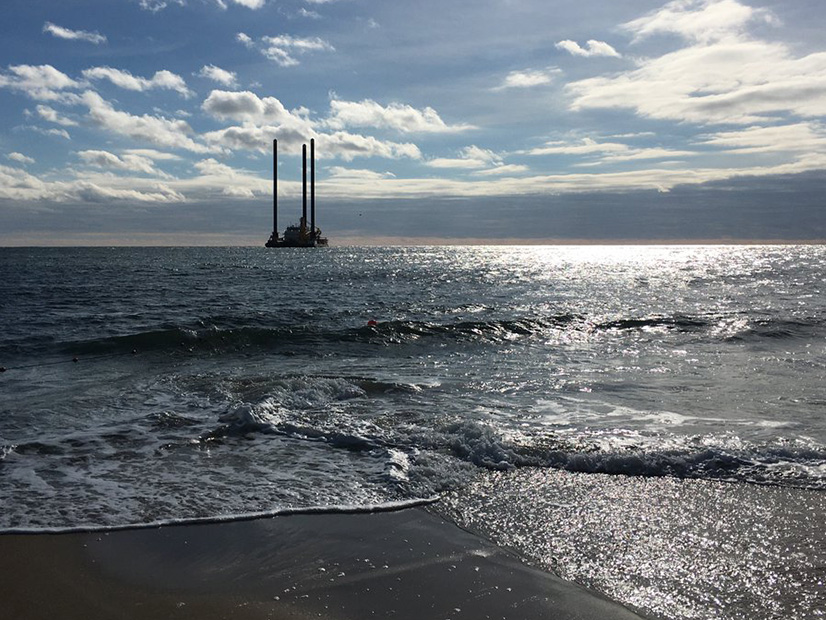
Wind power development off the coast of the Northeast U.S. continued to advance in 2022.
Extensive progress outweighed setbacks that arose, as construction on the first projects began or continued and several additional gigawatts of offshore wind (OSW) inched through various stages of the planning and approval process.
On the other side of the ledger, a developer moved to cancel agreements it said were no longer viable for a 1,200-MW wind farm off the Massachusetts coast, although it said it remained interested in developing the project under other terms.
On the whole, particularly in New York, it was a “banner year” that saw “monumental progress,” said Fred Zalcman, director of the industry group New York Offshore Wind Alliance.
“Looking forward to 2023, New York needs to build on this fantastic progress by awarding new contracts, with associated economic development, that will allow New York to achieve its 9-GW target,” Zalcman said in a December news release.
He also flagged one of the chokepoints that faces New York’s leaders in their efforts to decarbonize the state: moving all those new kilowatts from generator to consumer.
“New York also needs to make some key and timely decisions on transmission investments to facilitate the significant levels of offshore wind energy that we will need beyond the 9 GW,” Zalcman said.
Here are some of the larger developments in 2022.
New York
Winning bids totaling a record $4.37 billion were submitted in a February auction of federal lease rights to six tracts totaling 488,000 acres in the New York Bight.
The 130-MW South Fork Wind became the state’s first and the nation’s second large-scale OSW project to begin construction.
The state in July opened its third OSW solicitation, this one for at least 2 GW installed capacity, on its way to a self-imposed target of 9 GW capacity by 2035.
New York laid the groundwork for the physical and human infrastructure — factories, ports and career training — needed to support all this activity and allocated $500 million in funding for it.
Nearly a year of negotiations over plans for the 924-MW Sunrise Wind resolved a dispute over its potential effect on fishers. (It is an issue that may arise elsewhere: the U.S. Bureau of Ocean Energy Management has warned of potentially significant impact on commercial and for-hire recreational fisheries from other OSW projects in the New York Bight.)
BOEM and the National Oceanic and Atmospheric Administration completed a draft strategy to protect the endangered North Atlantic right whale from OSW development efforts.
Massachusetts
In August, Massachusetts Gov. Charlie Baker signed into law “An Act Driving Clean Energy and Offshore Wind,” codifying the goal of 5.6 GW of OSW nameplate generation capacity in Massachusetts by mid-2027.
Work continued on the 800-MW Vineyard Wind, which in late 2021 became the first large-scale OSW project in the nation to start construction.
The state in late December announced $180 million in funding to build up port infrastructure to support OSW projects.
Developers of the Commonwealth Wind and Mayflower Wind offshore projects said in October that the terms of the deals they had negotiated to sell the power from their planned wind farms were no longer tenable because of rising costs.
In December, Commonwealth moved to cancel those agreements but said it would rebid the 1.2-GW project if it was offered as part of a 2023 OSW solicitation by the state. (See Avangrid Seeks to Terminate Commonwealth Wind PPAs.) Mayflower Wind, which would provide 400 GW under the contracts in question, remained in development but the company would not comment on its plans.
Rhode Island
Rhode Island — home to the 30-MW Block Island Offshore Wind Farm, the first commercial OSW project in the U.S. — requested proposals for 600 to 1,000 MW of additional OSW.
Already in development is the 700-GW Revolution Wind, which is projected to go online in 2025 with 400 GW of power for Rhode Island and 300 GW for Connecticut.
Connecticut
In October, Avangrid pushed back by one year the target completion date of its 800-MW Park City Wind, which sits off the Massachusetts coast but will feed Connecticut’s grid. The developer said it hopes advances in technology in that year will allow it to extract more power from each turbine and improve the economics of the project. (Avangrid also pushed back Commonwealth Wind in Massachusetts for one year for the same reason.)
Maine
BOEM in August issued a Request for Interest in commercial OSW in the Gulf of Maine and received responses from five qualified developers.
Also in August, BOEM invited proposals for floating OSW turbine research in the Gulf of Maine.
New Jersey
In September, New Jersey kicked its OSW goal from 7.5 GW to 11 GW by 2040, the most of any state on the East Coast.
Three wind farms proposals totaling 3.7 GW are in some stage of review, and a port to support the projects is under construction in southwest New Jersey.


